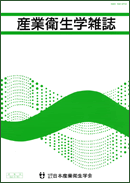All issues

Volume 55, Issue 1
Displaying 1-2 of 2 articles from this issue
- |<
- <
- 1
- >
- >|
Original
-
Machi Suka, Yuichi Miwa, Yoshiki Ono, Hiroyuki Yanagisawa2013 Volume 55 Issue 1 Pages 1-10
Published: February 20, 2013
Released on J-STAGE: February 26, 2013
Advance online publication: November 30, 2012JOURNAL FREE ACCESS FULL-TEXT HTMLObjective: To describe the 10-year changes in the prevalence of cardiovascular risk factors in Japanese workers. Methods: Annual health examination data between 2001 and 2011 were collected from the Tokyo Health Service Association. The data covers an average 119,956 (73,842 male and 46,114 female) workers at 1,159 worksites each year. The prevalences of obesity, hypertension, hypercholesterolemia, diabetes, and smoking were calculated in 5-year age groups for each year. Overall prevalence estimates were adjusted for age using the indirect method. Results: For male workers, the crude prevalences of obesity, hypertension, hypercholesterolemia, diabetes, and smoking were 26.9%, 19.0%, 22.7%, 6.9%, and 49.4%, respectively, in 2001, and 28.5%, 19.9%, 26.6%, 5.9%, and 34.4%, respectively, in 2011. The age-adjusted prevalence of hypercholesterolemia has increased over the 10-year period. Especially among those aged 50 years or over, significant increasing trends were found for obesity, hypertension, hypercholesterolemia, and diabetes. For female workers, the crude prevalences of obesity, hypertension, hypercholesterolemia, diabetes, and smoking were 10.4%, 7.1%, 19.1%, 1.7%, and 16.6%, respectively, in 2001 and 11.6%, 7.4%, 16.7%, 1.7%, and 10.3%, respectively, in 2011. The age-adjusted prevalence of hypercholesterolemia has decreased over the 10-year period. Especially among those aged 40–59 years, a significant decreasing trend was found for hypercholesterolemia. Smoking prevalence showed a steady decrease among both male and female workers. Conclusions: Overall cardiovascular risk prevalence of Japanese workers has remained almost unchanged over the 10-year period, but there is a significant increasing trend in the prevalence of hypercholesterolemia among male workers. Male workers aged 50 years or over are identified as a subgroup requiring special attention, whose cardiovascular risk prevalence is increasing.View full abstractDownload PDF (1537K) Full view HTML
Field Study
-
Kensuke Yoshimura, Norito Kawakami, Akizumi Tsusumi, Akiomi Inoue, Yuk ...2013 Volume 55 Issue 1 Pages 11-24
Published: February 20, 2013
Released on J-STAGE: February 26, 2013
Advance online publication: December 21, 2012JOURNAL FREE ACCESS FULL-TEXT HTML
Supplementary materialObjectives: To determine the cost-benefits of primary prevention programs for mental health at the workplace, we conducted a meta-analysis of published studies in Japan. Methods: We searched the literature, published as of 16 November 2011, using the Pubmed database and relevant key words. The inclusion criteria were: conducted in the workplace in Japan; primary prevention focus; quasi-experimental studies or controlled trials; and outcomes including absenteeism or presenteeism. Four studies were identified: one participatory work environment improvement, one individual-oriented stress management, and two supervisor education programs. Costs and benefits in yen were estimated for each program, based on the description of the programs in the literature, and additional information from the authors. The benefits were estimated based on each program’s effect on work performance (measured using the WHO Health and Work Performance Questionnaire in all studies), as well as sick leave days, if available. The estimated relative increase in work performance (%) in the intervention group compared to the control group was converted into labor cost using the average bonus (18% of the total annual salary) awarded to employees in Japan as a base. Sensitive analyses were conducted using different models of time-trend of intervention effects and 95% confidence limits of the relative increase in work performance. Results: For the participatory work environment improvement program, the cost was estimated as 7,660 yen per employee, and the benefit was 15,200–22,800 yen per employee. For the individual-oriented stress management program, the cost was 9,708 yen per employee, and the benefit was 15,200–22,920 yen per employee. For supervisor education programs, the costs and benefits were respectively 5,209 and 4,400–6,600 yen per employee, in one study, 2,949 and zero yen per employee in the other study. The 95% confidence intervals were wide for all these studies. Conclusions: For the point estimates based on these cases, the participatory work environment improvement program and the individual-oriented stress management program showed better cost-benefits. For the supervisor education programs, the costs were almost equal to or greater than the benefits. The results of the present study suggest these primary prevention programs for mental health at the workplace are economically advantageous to employers. Because the 95% confidence intervals were wide, further research is needed to clarify if these interventions yield statistically significant cost-benefits.View full abstractDownload PDF (1243K) Full view HTML
- |<
- <
- 1
- >
- >|